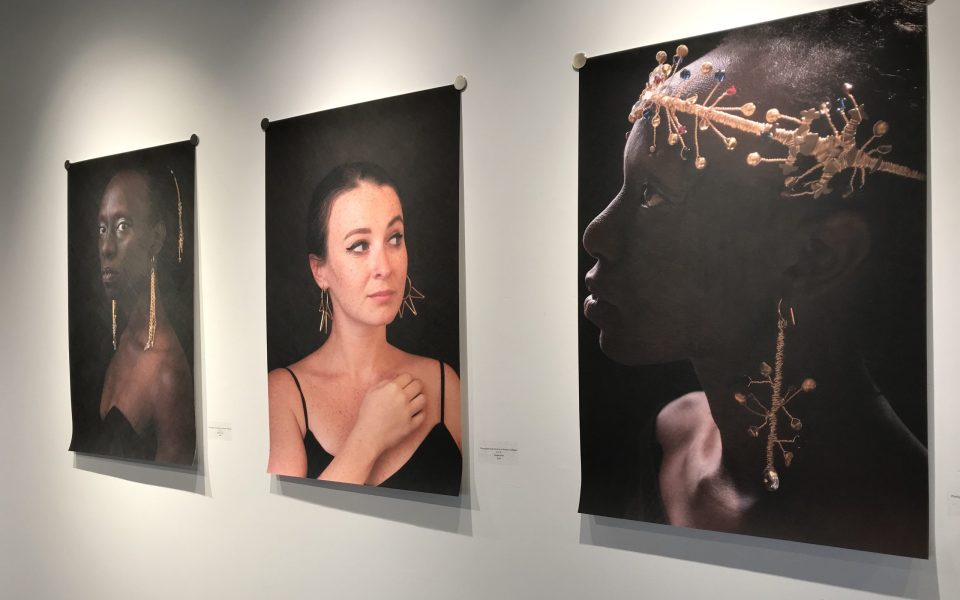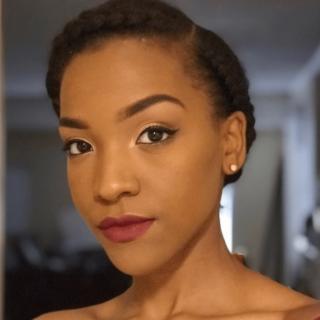Featured photo: Models Jerotich Yegon and Emily Ortiz Badalamente wears Nannette Gati Davis’ handcrafted jewerly in photos taken by Jasmine Huff. (photo by Michaela Ratliff)
Jewelry designer Nannette Gatti Davis doesn’t consider diamonds to be her best friend.
“I don’t do a lot of stonework,” says Davis, who sometimes goes by “Nann”. “I can do it; I have done it. I just don’t enjoy it.”
The metal designs instructor at Sawtooth School for Visual Art prefers copper, silver and brass as her media of choice when she’s making jewelry, drawing inspiration from nature. Pieces from her most recent collections are currently on display as part of a joint exhibition in the Arboreal Gallery at Milton Rhodes Center for the Arts.
The exhibition, FORM/TEXTURE/LIGHT/SHADOW, is a collaborative effort with photographer and filmmaker Jasmine Huff, who earned her MFA in documentary media at Northwestern University. The goal of the exhibition was to capture not only the craft of jewelry-making, but the ways in which jewelry changes the wearer.
Huff says the exhibition is defined by its underlying intersectional feminism — the overlapping of different women’s experiences with oppression and discrimination. She was delighted to see a Black model, Jerotich Yegon, embody royalty when she photographed Yegon wearing Davis’ 14-karat gold wire headband with Swarovski crystals, pearls and semi-precious stones.
“There’s a couple pieces of Jerotich that kind of take my breath away because it’s cool to see a Black woman in that way,” Huff says. “Just seeing someone that’s not just there to be looked at or to be made into a spectacle, and it means something when you see her both powerful and royal.”

Thanks to Winston-Salem Fashion Week organizer Nikita Wallace, Davis’ pieces in the exhibition were featured in WSFW 2018, when she provided custom accessories for designer Puja Arora’s clothing line. Arora made her way to New York Fashion Week in 2019, taking Davis’ jewelry with her. Davis specifically designed each accessory to match its paired garment.
“I design the jewelry to be an asset or an elevation piece instead of trying to compete with the work,” Davis says.
As Davis was designing the jewelry, she was satisfied with taking pictures of the pieces alone until she realized photographing them on bodies would elevate her handiwork.
“When you see [jewelry] on a person, you see it changes how people even stand,” she says.
She approached Huff, whose photography she loved, and asked her to photograph the jewelry, to which Huff agreed. During the project, Huff gained a new appreciation for Davis’ craft, as she not only got to see the jewelry created firsthand, but she also discovered pieces she’d never heard of, including a back necklace.
“What I love about Nann in particular is that there’s a specific purpose with which she makes work,” Huff says. “She would say, ‘I have a back necklace,’ and I’d never seen a back necklace and couldn’t imagine what that looked like.”
Yegon models the gold back necklace decorated with a waterfall of chains, each thread interrupted by squares of various sizes. The stones at the bottom of each segment move with the wearer, cascading and creating the illusion that the jewelry is a part of them.

Huff also believes Davis’ work displays the right balance of making a bold statement, but gently.
“It feels both kind of heavy, almost like armor, while simultaneously being delicate and I would use ‘feminine’ in a traditional way,” Huff says.
The exhibition was scheduled to debut earlier this year but was postponed until Aug. 15 due to the coronavirus. Curator Lindsay Piper Potter-Figueiredo, believes everything still fell into place regardless of the obstacles the group faced.
“The process of curating this exhibition happened nearly seamlessly and was about as harmonious as it could be, despite a global pandemic,” she says.
To Potter-Figueredo, the two artists’ work speaks for itself.
“When we arrived to install the exhibition, Jasmine had a clear vision of how she wanted the exhibition to be represented,” she says. “Nannette and I came in, masks on and had the entire exhibition installed within a matter of hours.”
The exhibition features the jewelry situated in a clear box or hanging on the wall with a description to its right. The photos by Huff featuring the jewelry are displayed on the wall behind or next to the jewelry on 24-by-36 bespoke wallpaper. The jewelry alone is beautiful, as the clear box allows the viewer to see the craftsmanship of the stone placements and shapes created with wire from all angles, but when the earthy tones of gold and silver accented by stones are worn, they create a sense of confidence in the model. Emily Ortiz Badalamente, an art therapist who modeled for the project, was photographed in a pair of silver chandelier earrings, adorned with glass pearls and Swarovski crystals.

“I started off being really self-conscious, but the energy and excitement of the shoot made the nerves go away fairly quickly,” says Badalamente.
The title of the exhibition was chosen because it represents important elements to consider in both jewelry designing and photography.
“Part of the reason we picked the title is because it’s interplay of our two mediums,” Huff says.
“I like the fact that the two of us, five if you include the models, were able to cross different experiences of mediums. Everyone was able to add something to it.”
The exhibit is available to view in person Monday through Friday from 9 am to 7 pm, Saturdays from 9 am to 4 pm and online until October 15th. There will be a virtual Q&A with the artists, models and curator on October 2nd. To learn more about Jasmine Huff or Nannette Gatti Davis, visit their websites.
Join the First Amendment Society, a membership that goes directly to funding TCB‘s newsroom.
We believe that reporting can save the world.
The TCB First Amendment Society recognizes the vital role of a free, unfettered press with a bundling of local experiences designed to build community, and unique engagements with our newsroom that will help you understand, and shape, local journalism’s critical role in uplifting the people in our cities.
All revenue goes directly into the newsroom as reporters’ salaries and freelance commissions.


Leave a Reply